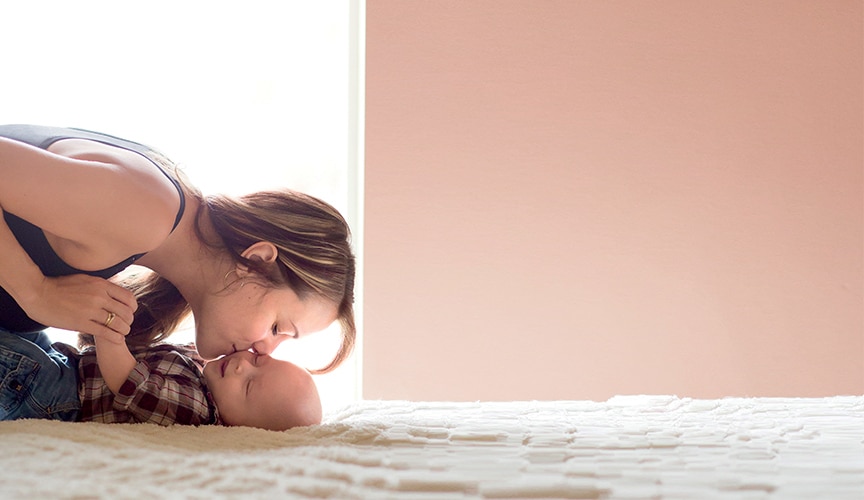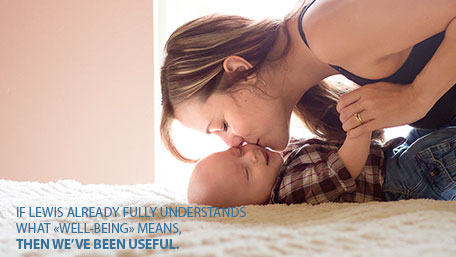What is cradle cap?
Completely harmless and not presenting any danger to newborns, cradle cap often worries and bothers parents.
They are keen to find out all they can about cradle cap that appears for no obvious reason on their newborn's scalp.
The causes of cradle cap are not precisely known; however, to date, there are several leads on the factors influencing its appearance. It may be related to an excess production of sebum by the skin, causing the proliferation of a yeast naturally present on the skin surface (yeasts of the Malassezia genus). This yeast causes inflammation and accelerates the elimination of dead cells that lead to scales visible on the surface of the scalp.
People often distinguish between two types of cradle cap:
- The so-called dry form, which appears in the first weeks of life after birth and predisposes the baby to oily skin in adulthood.
- And the so-called wet form, which is accompanied by oozing and is believed to be part of allergic eczema in infants.
Cradle cap is benign and fortunately not bothersome for babies. However, it is unsightly and can be uncomfortable for parents. If you choose to treat it, it is important to understand what cradle cap is so that you can use care products to prevent it from persisting, spreading or becoming infected.
How can you recognize cradle cap?
It is easy to recognize cradle cap. The lesions manifest themselves in typical forms as erythematous plaques (= red plaques) covered with thick, greasy, yellowish scales (= dead skin) on the top of the head and across the anterior fontanel (= space between the skull bones of newborns, which gradually ossifies during growth). The fontanel is the meeting point of the skull bones located on top of the skull. It is an area that is still open and soft in the first weeks of life, so one does not always dare to touch or treat it; however, this area is not especially fragile and can tolerate a gentle wash.
Sometimes cradle cap extends beyond the scalp, to the eyebrows, certain skin folds or even the buttocks.
Cradle cap does not cause any alteration of the general condition and does not lead to any discomfort or itching. In most cases, the lesions disappear in a few weeks or even less but they can sometimes persist until the child is two or three years old.
Sometimes cradle cap extends beyond the scalp, to the eyebrows, certain skin folds or even the buttocks.
Cradle cap does not cause any alteration of the general condition and does not lead to any discomfort or itching. In most cases, the lesions disappear in a few weeks or even less but they can sometimes persist until the child is two or three years old.
What should you do about cradle cap?
Contrary to popular belief, cradle cap has nothing to do with insufficient or inadequate hygiene.
It is the result of an excess of sebum which traps scales or dead cells produced in excess on the surface of the skin.
The condition is benign and harmless, so what should you do about cradle cap?
In the majority of cases, infant seborrheic dermatitis is transient and disappears with simple cleansing measures. It is recommended to use a gentle soap-free shampoo specially formulated for babies.
When the crusts are present in large quantities or very thick, you may wish to use specific care products to treat them.
Treatments or lotions, which are applied before washing, or shampoos with keratolytic action (action that removes dead cells) to promote the elimination of scales can be recommended alone or in combination.
After each bath and once the hair is well rinsed, brush gently with a hairbrush suitable for infants so as not to irritate the scalp. The mechanical action of the brushing will make it possible to eliminate cradle cap crusts, which detach more easily thanks to the action of the product.
If the treatments do not work after a few weeks, or if cradle cap spreads, or if there is strong inflammation of the scalp (redness), a consultation with your family physician is necessary.
It is the result of an excess of sebum which traps scales or dead cells produced in excess on the surface of the skin.
The condition is benign and harmless, so what should you do about cradle cap?
In the majority of cases, infant seborrheic dermatitis is transient and disappears with simple cleansing measures. It is recommended to use a gentle soap-free shampoo specially formulated for babies.
When the crusts are present in large quantities or very thick, you may wish to use specific care products to treat them.
Treatments or lotions, which are applied before washing, or shampoos with keratolytic action (action that removes dead cells) to promote the elimination of scales can be recommended alone or in combination.
After each bath and once the hair is well rinsed, brush gently with a hairbrush suitable for infants so as not to irritate the scalp. The mechanical action of the brushing will make it possible to eliminate cradle cap crusts, which detach more easily thanks to the action of the product.
If the treatments do not work after a few weeks, or if cradle cap spreads, or if there is strong inflammation of the scalp (redness), a consultation with your family physician is necessary.
What are the remedies for cradle cap?
Cradle cap is not a new condition! Our grandmothers already had their tricks and remedies against it! These included the use of fatty substances (Vaseline, etc.), to be applied to the baby's scalp two hours before the bath to soften the crusts and facilitate their removal. When the infant does not yet have hair, it is advisable to use liniment or olive oil instead of Vaseline.
Other more natural remedies whose efficacy has not yet been scientifically proven such as breast milk, homeopathic solutions, etc. have been tested by many mothers.
In addition to treatments, whether natural or not, it is particularly important to adopt cleansing measures with suitable products to soothe the scalp, limit the risk of new irritation and avoid the formation of new crusts.
Cradle cap is a common but mostly transitory skin condition; it does not leave traces on the skin and is not necessarily a sign that seborrheic dermatitis will develop in adulthood.
The term cradle cap is very specific to infants. When adults are affected by a skin condition resembling it, it is either simple dandruff or adult seborrheic dermatitis. This is a chronic condition which progresses in flare-ups and differs from the infant form in various ways.
Other more natural remedies whose efficacy has not yet been scientifically proven such as breast milk, homeopathic solutions, etc. have been tested by many mothers.
In addition to treatments, whether natural or not, it is particularly important to adopt cleansing measures with suitable products to soothe the scalp, limit the risk of new irritation and avoid the formation of new crusts.
Cradle cap is a common but mostly transitory skin condition; it does not leave traces on the skin and is not necessarily a sign that seborrheic dermatitis will develop in adulthood.
The term cradle cap is very specific to infants. When adults are affected by a skin condition resembling it, it is either simple dandruff or adult seborrheic dermatitis. This is a chronic condition which progresses in flare-ups and differs from the infant form in various ways.
Diagnosis: Do you have plaques, dandruff, redness, itching?


Do you have any of the following symptoms in your scalp and/or face and body?
It could be psoriasis, seborrheic dermatitis, or even eczema.
Make the diagnosis "Plaques, dandruff, redness and/or itching?" to discover our advice and recommendations for adapted care routines.
- plaques
- dandruff
- redness
- itching
It could be psoriasis, seborrheic dermatitis, or even eczema.
Make the diagnosis "Plaques, dandruff, redness and/or itching?" to discover our advice and recommendations for adapted care routines.


